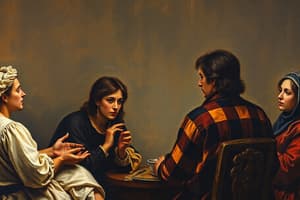Podcast
Questions and Answers
What defines a group according to Vaughn and Hogg?
What defines a group according to Vaughn and Hogg?
- Individuals who do not interact with each other.
- Two or more individuals who share similar interests.
- Individuals connected by shared geographical location.
- Two or more individuals who share a common definition and evaluation of themselves. (correct)
What characterizes primary groups?
What characterizes primary groups?
- Goal-focused and professional
- Formed spontaneously without planning
- High levels of cohesiveness and solidarity (correct)
- Large and short-term
According to Forsyth, what characteristic is essential for defining a group?
According to Forsyth, what characteristic is essential for defining a group?
- Members must have a common goal or ambition.
- Members must belong to the same geographical area.
- Members must be connected to each other by a social relationship. (correct)
- Members must share similar personality traits.
Which of the following best describes the nature of a group with only a few members, according to the discussion?
Which of the following best describes the nature of a group with only a few members, according to the discussion?
Which type of group is formed deliberately by individuals or authorities for specific purposes?
Which type of group is formed deliberately by individuals or authorities for specific purposes?
What term describes the feeling of belonging among group members, according to Johnson's definition?
What term describes the feeling of belonging among group members, according to Johnson's definition?
Which of the following is an example of an emergent group?
Which of the following is an example of an emergent group?
What distinguishes a task group from other types of groups?
What distinguishes a task group from other types of groups?
How does the size of a group influence its nature according to Forsyth?
How does the size of a group influence its nature according to Forsyth?
Which type of group typically has very permeable boundaries and lasts for only a brief period?
Which type of group typically has very permeable boundaries and lasts for only a brief period?
What kind of ties can exist between group members?
What kind of ties can exist between group members?
What distinguishes a group from a category?
What distinguishes a group from a category?
What is the primary focus of secondary groups?
What is the primary focus of secondary groups?
What is a characteristic of categories as described in the content?
What is a characteristic of categories as described in the content?
What defines a self-organizing group?
What defines a self-organizing group?
Which of the following examples best illustrates a primary group?
Which of the following examples best illustrates a primary group?
Flashcards are hidden until you start studying
Study Notes
Definition of Group
- Vaughn and Hogg (2002) define a group as two or more individuals sharing a common self-definition and evaluation.
- Johnson (1995) describes a group as a social system with regular interaction and a common identity, fostering a sense of “we-ness” among members.
- Forsyth (2007) views a group as two or more individuals connected through social relationships, ranging from two members to thousands.
Characteristics of Group Size
- Small groups (2-3 members) possess unique characteristics due to their limited size, offering more intimate dynamics.
- As group size increases, complexity and formal structure tend to rise, affecting interaction and relationships.
Nature of Connections Within Groups
- Individuals in a group are networked, creating ties that can be either strong (deep emotional bonds) or weak (easily broken relationships).
- Weak ties can still lead to significant outcomes across the networked group.
- Social connections among members distinguish groups from mere categories, which are simply aggregations of individuals sharing certain traits.
Types of Groups
- Primary Groups: Small, long-term relationships focused on face-to-face interaction, high cohesiveness, and member identification (e.g., families, close friends, gangs).
- Secondary Groups: Larger, less intimate, goal-oriented groups typical in complex societies (e.g., work groups, unions, professional associations).
- Planned Groups: Formed either deliberately by members or by external authority for specific purposes.
- Concocted Groups: Planned by outside authorities (e.g., production lines, military units).
- Founded Groups: Planned by individuals within the group (e.g., study groups, clubs).
- Emergent Groups: Spontaneous formations as individuals interact repeatedly over time and settings.
- Circumstantial Groups: Unplanned, arising from external situational forces (e.g., crowds, waiting lines).
- Self-organizing Groups: Evolve from individuals aligning their activities cooperatively (e.g., workplace cliques, study groups).
- Intimacy Groups: Moderate-duration, small groups characterized by substantial interaction (e.g., families, romantic couples).
- Task Groups: Goal-focused work groups in various settings (e.g., teams, neighborhood associations).
- Weak Associations: Spontaneous forms lasting briefly with permeable boundaries (e.g., crowds, audiences).
- Social Categories: Aggregations of individuals with similar qualities without the relational ties found in groups.
Studying That Suits You
Use AI to generate personalized quizzes and flashcards to suit your learning preferences.




